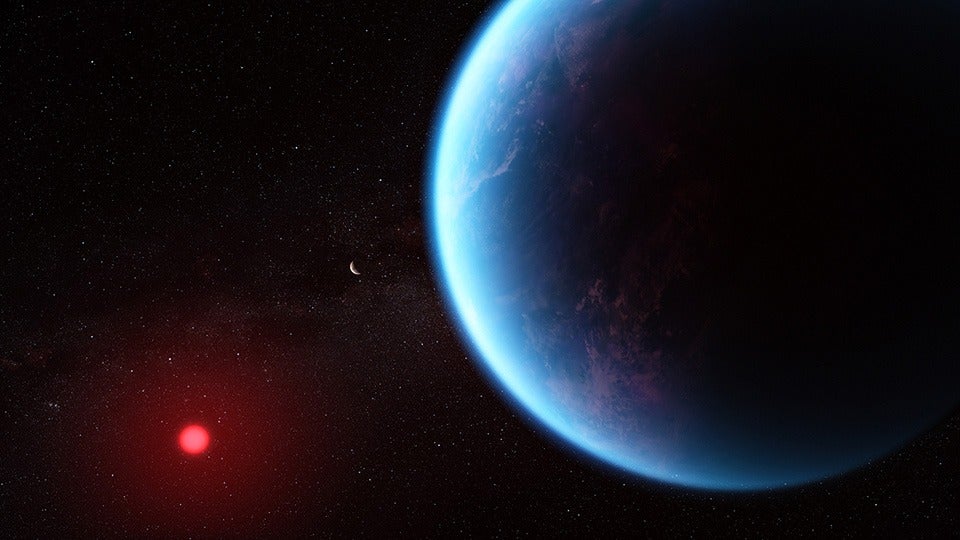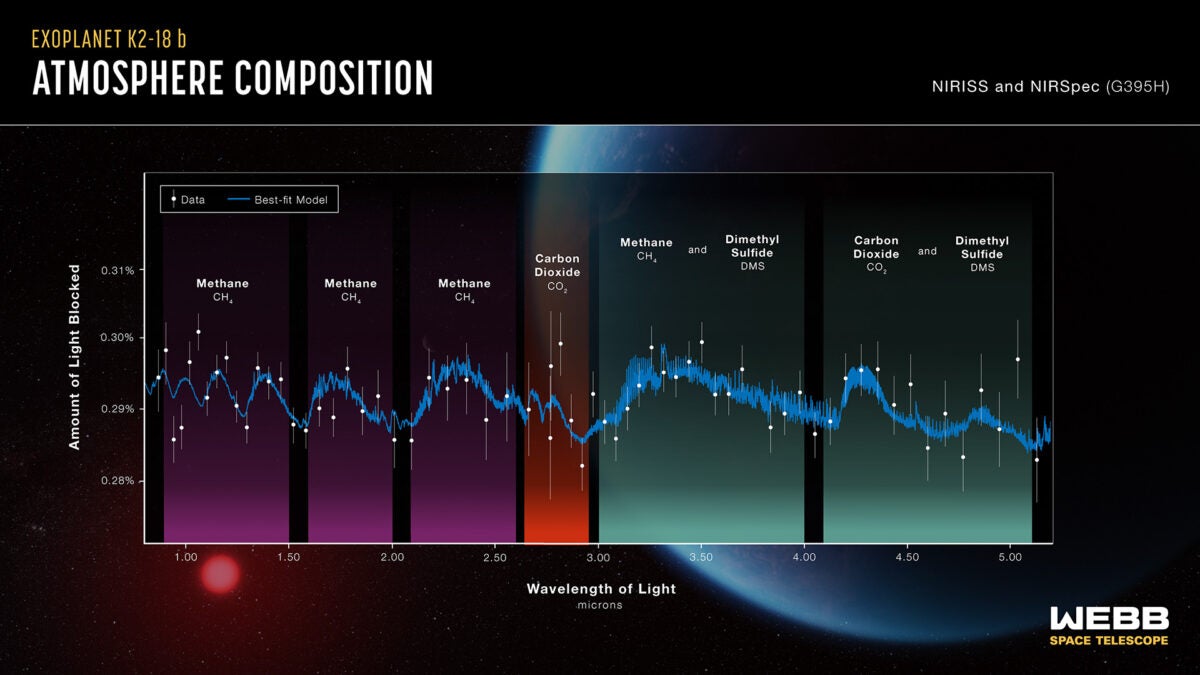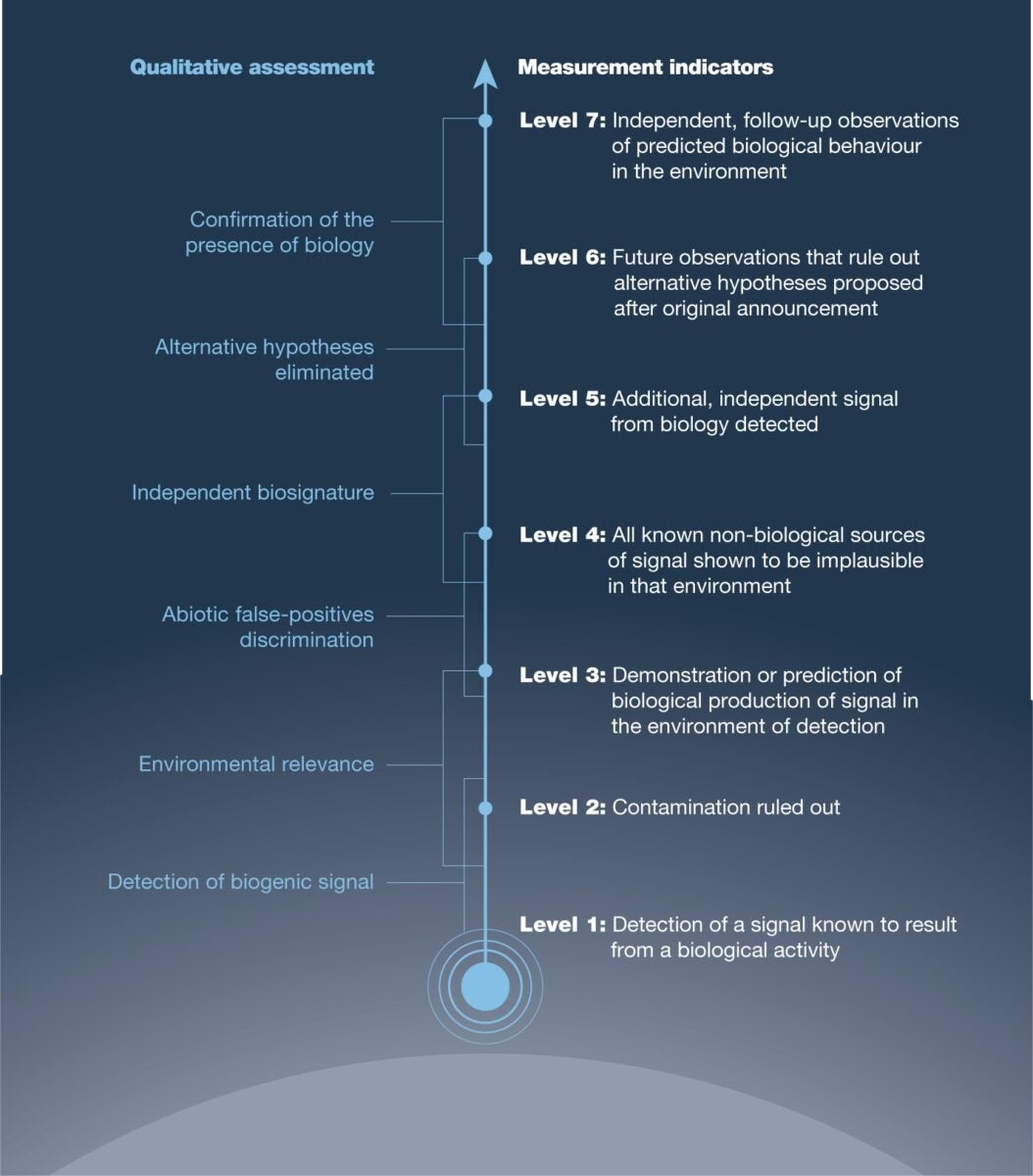
Welcome to the Astronomy.com roundtable where our editors help explain (and sometimes debate) hot topics. This week, Astronomy’s Dave Eicher, Alison Klesman, Daniela Mata, and Mark Zastrow weigh in on the possibility of life on the exoplanet K2-18 b.
Astronomy.com: The exoplanet known as K2-18 b was discovered with the Kepler Space Telescope in 2015. It orbits an M dwarf star in the constellation Leo. It’s 124 light-years away from Earth.
Multiple news agencies recently reported on the news from researchers using the James Webb Space Telescope to take a closer look at this intriguing exoplanet. Early this year several researchers made statements on recent Webb findings that suggest a planet perhaps friendly to life, or even containing life, have sparked recent discussions.
Here is how NASA describes it: “Webb’s discovery adds to recent studies suggesting that K2-18 b could be a Hycean exoplanet, one which has the potential to possess a hydrogen-rich atmosphere and a water ocean-covered surface.”
Did we find “life” on K2-18 b?
Dave Eicher: No. We haven’t found signs of life on K2-18 b. Just as the numerous claims of astronomers discovering “exoplanets just like Earth” have wishfully jumped the gun, some astronomers are a little ahead of the game again. The planet’s spectrum is tantalizing to some and much ado about nothing to others. It is rich in hydrogen, unlike our primarily nitrogen atmosphere. Some planetary scientists believe it’s likely that K2-18 b has liquid oceans, which might increase the possibility of life. Last year researchers found evidence of carbon dioxide and methane in the spectrum, and this again could point toward a living ecosystem on the world. Further, last year observations revealed dimethyl sulfide, a compound that on Earth is produced largely by phytoplankton. But the data are inconclusive. This may mean something, and it may not. And that’s likely where we’ll be for a long time. Other exoplanets may reveal massive excesses in carbon dioxide, methane, or other compounds, and these may scream out more loudly from afar that life is present. But hey folks, we ain’t there yet.
Astronomy.com: Alison?
Alison Klesman: Sorry, but nope! I’m largely echoing what what Dave has said, but so far what astronomers have discovered about this world is that K2-18 b is possibly a Hycean planet, which is a fancy term for saying it could host a surface ocean of water and hydrogen atmosphere. Furthermore, astronomers are saying this might be the case not based on the detection of an actual water ocean or a hydrogen atmosphere, but based on the detection or non-detection of other elements and molecules (i.e., abundant carbon dioxide and methane, and a lack of ammonia) in the planet’s atmosphere, from which they infer such an ocean or atmosphere could exist.
(Have I emphasized enough words in the previous paragraph to indicate that all of this is indirect evidence for certain conditions on the planet? I hope so!)

Additionally, even if we were absolutely sure that K2-18 b had a hydrogen atmosphere and a surface ocean of water, neither of them — separately or together — is tantamount to the discovery of life. All the discovery of those two things would say is that the planet is potentially habitable for some kind of life as we understand it, certainly not that it is inhabited by any life, Earth-like or otherwise.
RELATED: What would signal life on alien planets? | What happens if SETI detects alien life
I also want to highlight the fact that the detection of dimethyl sulfide (that tantalizing biomarker of life) is not even a firm finding at all! Straight from this paper’s abstract, “the spectrum also suggests potential signs of dimethyl sulfide.” Take note of that wording: suggests potential signs. I just want to reiterate that this means dimethyl sulfide has not yet been unequivocally detected.
All this probably makes me sound pretty pessimistic, and I want to add that I absolutely believe there is some other form of life (Earth-like or otherwise!) out there in the universe, and perhaps even on this particular planet! But to answer this specific question, no, we absolutely have not found life on K2-18 b based on the information we have so far.
Astronomy.com: That’s two nopes! This pessimism is good. Remember the meteorite that purportedly had evidence of organic life on Mars? It would take something unprecedented to produce a true “a ha!” moment. Daniela and Mark, you’re up.
Daniela Mata: As much as we may want to believe that our extraordinary habitable planet is not alone, unfortunately, as of now, that is still very much true. Just as Dave and Alison have explained, sometimes planetary scientists get excited and tend to embellish what was detected, or not detected, in exoplanets’ biosignatures. And when that happens, it’s comes down to semantics and you have to look for those magic words (i.e. “suggests” or “potential”), to discern if these findings are concrete or mere proposals.
This is not to say that we should dismiss the dedicated time and effort these scientists have put into their work. The fact that JWST revealed the presence of methane and carbon dioxide in K2-18 b, adding to the support that K2-18 b could be a Hycean exoplanet, is a monumental find! K2-18 b is the smallest planet that has detectable atmospheric features and lies in the host star’s habitable zone (also called the Goldilocks zone). And as Alison explains, a Hycean exoplanet has a liquid water ocean and hydrogen-rich atmosphere, which is fully possible in the Goldilocks zone.
However, given the fact that K2-18 b is about 2 ½ times the Earth’s radius and has a hydrogen-rich atmosphere that can extend much further than that of Earth’s, this creates a major obstacle in the exoplanet’s path to habitability. And with an extended atmosphere like that, it makes the planet more like Neptune rather than Earth.
If an astronaut were to visit K2-18 b, they would experience a drastic increase in temperature and pressure as they moved toward the center of the planet. Let’s say the astronaut was somehow indestructible and managed to travel to the exoplanet’s core, the temperature could reach about 5,000 degrees Fahrenheit (2,700 degrees Celsius) and have pressure thousands of times stronger than Earth’s surface.
That being said, even on the deep-surface of K2-18 b, complex molecules needed for life to thrive, simply cannot thrive; the conditions are not stable enough. Hence, no signs of life from this exoplanet.
For the time being, if you see a headline stating, “Signs of life detected,” or something similar, take a pause and keep an eye out for Astronomy’s coverage of the study. And most importantly, may it remind you how precious and delicate our Earth truly is, and how it deserves better than the way humans have been treating it.
Mark Zastrow: Same one-word answer: No.
But I’ll add a small bit of media commentary.
Consider the notional headline: “NASA’s Curiosity rover finds signs of life on Mars.” Well, Curiosity has indeed found methane on Mars. And methane is a sign of life. So, it could be argued, in a pedantic and transitive sense, that the headline is not false.
The problem is that methane is also a sign of not-living, geological things, which can be as mundane as methane seeping up through cracks in the ground.
So even if astronomers go on to gather more data and evidence for dimethyl sulfide on K2-18 b, having a firm detection of it doesn’t mean that we have found life.
In fact, it’s almost misleading to say that astronomers will ever “find” life, at least in the everyday sense of the word “find”. It’s a bit different for robotic and human explorers; if an astronaut lands on Europa and is attacked by a subsurface kraken, then the headline “Alien life found” would be accurate. But for astronomers who will never visit the world they are studying, “finding” life doesn’t mean just obtaining evidence that life on a world exists — it also means having to demonstrate that all known nonliving sources of said evidence cannot exist on that world. In other words, it’s not enough to do the hard work of finding life — you also have to do an incredible job of not finding not-life.
This is just one way in which we as science writers struggle with the English language to convey uncertainty. We usually end up leaning on words like “potential” or “evidence of” or “signs of”. But as markers of uncertainty, these words are sort of stop-gap solutions, borrowed for the purpose — they still point, if tentatively, in one direction. They don’t truly convey uncertain states of knowledge. And right now, any conclusions about life to be drawn from exoplanet observations are very uncertain, indeed.

When JWST was still under development 15 or 20 years ago, there was speculation that it would be able to detect biosignatures. It was often talked about, by scientists and media alike, as the next big hope for finding life in the universe. But around 10 years ago, as astronomers did more detailed modeling of planetary atmospheres and JWST’s capabilities, the consensus emerged — and remains — that JWST could tease out tantalizing hints of biosignatures, but likely wouldn’t be powerful enough to make a firm detection.
That’s exactly what we’re seeing play out with planets like K2-18 b. And it’s why NASA is already planning a new flagship space telescope called the Habitable Worlds Observatory, which will be expressly built (with technology that has yet to be fully developed) to detect life on earthlike worlds in nearby star systems. That’s a long ways off, though; HWO is currently set to launch in the 2040s.
So until then, we’re in this weird messy place where astronomers using JWST will likely, in the near future, find dozens or even hundreds of planets that could be said to have “evidence of signs of life.” Yet, at the same time, we’ll likely be unable to determine whether a certain spectral line is definitely the molecule that we hope it is, and also whether it’s from life or not-life.
Because of the difficulty in communicating this uncertainty — and the sensationalism that can result — in 2021, a group of NASA scientists proposed a “Confidence of Life Detection” scale (CoLD for short). The CoLD scale has seven stages, corresponding to increasing levels of confidence for the existence of alien life. The first step is simply detecting a signal that can be produced by life. Level 2 involves ruling out contamination in the signal, and level 3 is to work out a plausible mechanism for life to produce the signal. Level 4 is showing that all non-living sources of the signal are implausible in that environment, and the remaining levels involve additional follow-up verification work.

This has not yet been widely adopted, and the team themselves say it’s more of a proof-of-concept, intended to provoke discussion. But I find the concept useful as it gives us a framework to compare claims and put them into context. So when we report that “Researchers say they have discovered phosphine on Venus, a potential sign of life,” we can also say: “The team is effectively claiming a CoLD-level-3 detection, as they say they have ruled out contamination (level 2) and proposed a hypothesis of how life could exist in venusian clouds (level 3). But many researchers dispute their level-2 claim, and argue other sources can explain the signal, including sulfur dioxide.”
For comparison, the aforementioned martian meteorite ALH84001 could be said to fall around the same place in the scale — a level-3 claim, but with level 2 disputed. K2-18 b and its possible dimethyl sulfide signal are sitting tentatively on level 1, with further JWST observations pending.









